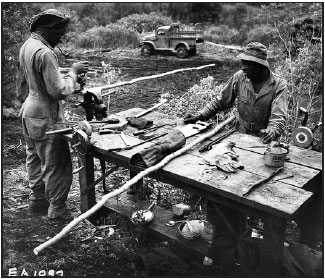Alaska lauds black soldiers' work on WWII highway
ANCHORAGE, Alaska - Leonard Larkins and nearly 4,000 other segregated black soldiers helped build a highway across Alaska and Canada during World War II, a contribution largely ignored for decades but drawing attention as the 75th anniversary approaches.
In harsh conditions and tough terrain, it took the soldiers working from the north just over eight months to meet up with white soldiers coming from the south to connect the two segments on Oct 25, 1942. The 2,400-kilometer route set the foundation for the only land link to Alaska.
The project to build a supply route between Alaska and Canada used 11,000 troops from the US Army Corps of Engineers divided by race, working under a backdrop of segregation and discrimination. The soldiers connected the road in Canada's Yukon Territory east of the border of what was then the United States territory of Alaska.
State lawmakers voted this year to set aside each Oct 25 to honor black soldiers who worked on the Alcan Highway, now called the Alaska Highway. They note the soldiers' work became a factor in the integration of the army in 1948.
Larkins, now 96 and living in New Orleans, applauds lawmakers for finally recognizing their role.
"It's way past time," said Larkins, who recently was back in Alaska for commemoration events.
A road link between Alaska and the Lower 48 was long a dream for territorial officials, but disagreements over a route and necessity caused delays until December 1941. The Japanese attack on Hawaii's Pearl Harbor sparked an urgency to build the link out of concern that the US territory and West Coast shipping lanes also were vulnerable. The southwest tip of Alaska's Aleutian Islands chain is just 1,206 km from Japan.
Larkins worked with the 93rd Engineers. His most vivid recollection remains the bone-chilling temperatures shocking to the young man from Louisiana.
"So cold," Larkins said. "You can't stand there too long, you know."
Before the project, black soldiers were considered incapable of front-line duty or sensitive deployments and were largely relegated to housekeeping and clerk duties, said historian and author Lael Morgan, who researched the project for its 50th anniversary. However, a shortage of men prompted the deployment of black soldiers to help carve out the initial route, said Morgan, who is largely credited with introducing their story to modern audiences.
"I'm delighted that credit is finally going to where credit is due," Morgan said. "We owe them for a job well done."
Associated Press
|
Soldiers work at a makeshift bench while during construction of the Alaska Highway, in the Northern Sector of Alaska, in 1942.Us Army Corps Of Engineers Office Of History Via Associated Press |



















